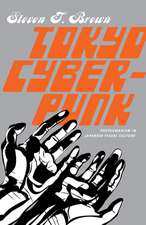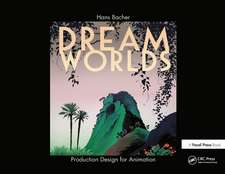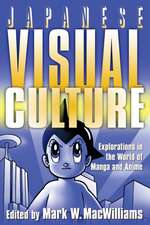Cinema Anime: Critical Engagements with Japanese Animation
Editat de Steven T. Brownen Limba Engleză Paperback – 16 noi 2008
| Toate formatele și edițiile | Preț | Express |
|---|---|---|
| Paperback (1) | 383.93 lei 43-57 zile | |
| Palgrave Macmillan US – 16 noi 2008 | 383.93 lei 43-57 zile | |
| Hardback (1) | 387.38 lei 43-57 zile | |
| Palgrave Macmillan US – 21 apr 2006 | 387.38 lei 43-57 zile |
Preț: 383.93 lei
Nou
Puncte Express: 576
Preț estimativ în valută:
73.49€ • 79.85$ • 61.77£
73.49€ • 79.85$ • 61.77£
Carte tipărită la comandă
Livrare economică 21 aprilie-05 mai
Preluare comenzi: 021 569.72.76
Specificații
ISBN-13: 9780230606210
ISBN-10: 0230606210
Pagini: 248
Ilustrații: VIII, 248 p. 19 illus.
Dimensiuni: 140 x 216 x 15 mm
Greutate: 0.32 kg
Ediția:2006
Editura: Palgrave Macmillan US
Colecția Palgrave Macmillan
Locul publicării:New York, United States
ISBN-10: 0230606210
Pagini: 248
Ilustrații: VIII, 248 p. 19 illus.
Dimensiuni: 140 x 216 x 15 mm
Greutate: 0.32 kg
Ediția:2006
Editura: Palgrave Macmillan US
Colecția Palgrave Macmillan
Locul publicării:New York, United States
Cuprins
Screening Anime - S.T. Brown Part I: Towards a Cultural Politics of Anime "Excuse Me, Who Are You?": Performance, the Gaze, and the Female in the Works of Kon Satoshi - S.Napier The Americanization of Anime and Manga: Negotiating Popular Culture - A.Levi The Advent of Meguro Empress: Decoding the Avant-Pop Anime TAMALA 2010 - T.Takayuki Part II: Post-Human Bodies in the Animated Imaginary Frankenstein and the Cyborg Metropolis - S.Orbaugh Animated Bodies and Cybernetic Selves: The Animatrix and the Question of Post-Humanity - C.Silvio The Robots from Takkun's Head: Cyborg Adolescence in FLCL - B.Ruh Part III: Anime and the Limits of Cinema The First Time as Farce: Digital Animation and the Repetition of Cinema - T.Lamarre "Such is the Contrivance of the Cinematograph" Dur(anim)ation, Modernity, and Edo Culture in Tabaimo's Animated Installations - L.Monnet
Recenzii
"Both cinema and animation have served simultaneously as transnational cultural forms as well as national forums, formed by specific discourses on nationalism and modernization. In fact, in the 1910s-20s Japan, animation was not defined as distinct from cinema in terms of social regulations or production concerns. Animation, together with cinema, came under the scrutiny of public educators, censors and national ideologues. The point of intersection for these diverse concerns was the construction of national cinema for international dissemination. The attempt of Cinema Anime to dismantle the distinction between cinema and animation, national cinema and transnational visual culture, is genuinely challenging, but definitely necessary in the tension-ridden period of media globalization."
-Daisuke Miyao, University of Oregon, USA
'Cinema Anime is an important and thought-provoking collection of essays by a number of the leading figures in the field. It includes some of the first scholarly work on several challenging and noteworthy anime that have not received enough academic attention up to now. With chapters that range from cross-cultural overviews to ambitious critical interventions, this volume will be of interest to a wide audience, from students to experienced scholars. Indeed, Cinema Anime should be required reading for anyone committed to anime criticism.'
-Christopher Bolton, Senior Editorial Board, Mechademia
"The brain is the screen," as quoted in the introduction, is an apt expression of Cinema Anime's aim to keep thinking in new ways about anime even as it gains its mindshare, to take new positions towards it even as it finds its place. Its academics know where to look within LAIN, the one show that best learned the liberating message of EVANGELION; Satoshi Kon, the most important anime director to emerge in the past decade and without, showing how film technology itself informs the narrative of anime and how contemporary installation artists draw it forth from flatland to examine our real space. Cinema Anime rephrases the question: where anime is, rather than what it is to be defined.
-Carl Gustav Horn, author of Strange Colors: The Power of Japanese Animation
'This is a worthy addition to any Anime fans' library or for those who want to study the media in more depth.' - Phil Jones, SF Crowsnest
-Daisuke Miyao, University of Oregon, USA
'Cinema Anime is an important and thought-provoking collection of essays by a number of the leading figures in the field. It includes some of the first scholarly work on several challenging and noteworthy anime that have not received enough academic attention up to now. With chapters that range from cross-cultural overviews to ambitious critical interventions, this volume will be of interest to a wide audience, from students to experienced scholars. Indeed, Cinema Anime should be required reading for anyone committed to anime criticism.'
-Christopher Bolton, Senior Editorial Board, Mechademia
"The brain is the screen," as quoted in the introduction, is an apt expression of Cinema Anime's aim to keep thinking in new ways about anime even as it gains its mindshare, to take new positions towards it even as it finds its place. Its academics know where to look within LAIN, the one show that best learned the liberating message of EVANGELION; Satoshi Kon, the most important anime director to emerge in the past decade and without, showing how film technology itself informs the narrative of anime and how contemporary installation artists draw it forth from flatland to examine our real space. Cinema Anime rephrases the question: where anime is, rather than what it is to be defined.
-Carl Gustav Horn, author of Strange Colors: The Power of Japanese Animation
'This is a worthy addition to any Anime fans' library or for those who want to study the media in more depth.' - Phil Jones, SF Crowsnest
Notă biografică
STEVEN T. BROWN is Associate Professor of Japanese Literature and Popular Culture at the University of Oregon, USA.









